No matter the SIZE of the department or the type of community served, the primary reason for placing the aerial in a particular place on a fire scene is exactly the same: effectiveness. Every department desires the most effective use of its device at each incident. Three factors impact the effectiveness of a device at a given scene: design, placement, and stabilization. This article addresses the positioning of the aerial for maximum effectiveness.
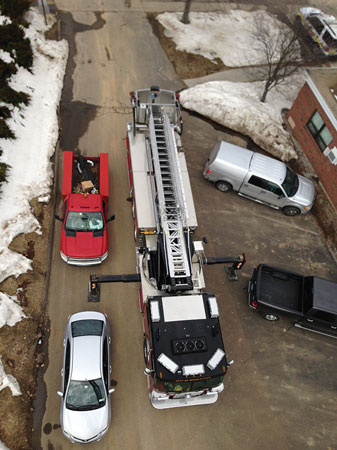 |
| (1) Taking a position in the center of the front of larger buildings and maximizing the scrub area. (Photos by Patrick Dooley unless otherwise noted.) |
Placement of the aerial ladder on the fireground receives less attention than it should in most texts. In many cases, the topic is framed from a very limited perspective and lacks the versatility the real world requires. This approach to the subject results in many apparatus operators answering the question, “Where should the truck be positioned?” with the vague answer, “The front of the building.” This response is too general. The practice of having the truck take the front of the building originated in larger municipalities, where the first aerial devices were put through their paces. In those districts, the only side of the building accessible to the aerial most times was the front of the building, and the front gave the device the best possible scrub area (photo 1). This standing practice has since been applied to all types of municipalities as the use of aerial devices has spread.
Not Necessarily a Predetermined Static Position
The idea that the position for aerial apparatus is predetermined and static is not necessarily wrong, but it is too vague. We need to teach our aerial operators that they should not just position the apparatus in the middle of the front of the building and hope for the best.
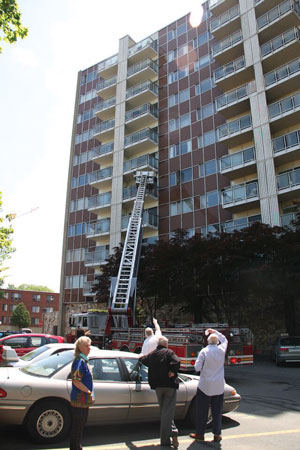 |
| (2) Stopping just short of your final position and having the spotter “walk” the apparatus into its final position save time in repositioning. They save time because the driver may have a hard time assessing obstructions from the cab. (Photo by author.) |
As a general rule when approaching most fire buildings, stop the aerial device one length short of the earliest possible placement position in front of the fire building, determine how the aerial will be used, and then select the best position for the apparatus (photo 2). This will allow for proper positioning and for adjusting the apparatus left or right, as needed, for its final operating position. The operator and the “spotter” determine how the device will be used. This issue can be decided quickly with only a few words spoken in the cab or may entail getting out of the cab and sizing up the situation.
Life Hazard
The positioning decision depends on various factors. The first question that must be answered is, “Is there a known life hazard?” This comes from our tactical priorities of RECEO VS (Rescue, Exposure, Confine, Extinguish, Overhaul, Ventilate, Salvage).
Rescue
If the aerial is to be positioned to address a known life hazard, it should be parked where it will optimally affect the rescue. In most cases, this means lining up squarely with the desired objective and positioning the device for victim removal.
For aerial ladders and platforms with front-facing bucket doors, line up the turntable perpendicular to the victim’s location. This allows the aerial device to be square to the objective. If the platform doors opens to the front, line up the bucket doors on the front of the platform so they are square with the victim’s location. You may have to use this method of positioning also for other platform devices because you have to allow for the location of the bucket door and its swing. If your platform has corner doors, line up the bucket as it sits in the bedded position perpendicular to the objective. This facilitates the door’s lining up with the victim and leaves the smallest gap possible once the platform has been raised to the objective. The operator needs to know and understand the specifics of each platform before an emergency occurs. Identify the operational parameters and nuances of a device at a drill or training session.
Exposure
If no immediate rescue is required, the next priority is exposures. In some cases, if an exposure needs protecting, the position of the apparatus would depend on the mode of operation. If it is defensive, position the apparatus to offer the greatest coverage for a master stream operation and to allow firefighters to observe the collapse zone. Often, positioning at the corners of the fire building offers protection from possible collapse and maximizes the versatility of the master stream. In an offensive operation, position the aerial to cover the most severely threatened exposure first (photo 3). Collapse zones are not as crucial in these situations because if you are conducting offensive firefighting operations in the primary fire building, the presumption is that the building is structurally sound.
Confinement
If rescue or exposure protection is not going to be conducted using the aerial device, the next question is, “Where is the best position to support confinement efforts?” Up to this point, a single required task has determined where the apparatus would be positioned. This allows for optimum positioning for that task. However, most incidents do not present a single task; most require the device to be operationally flexible. This means positioning for multiple uses and tactical operations.
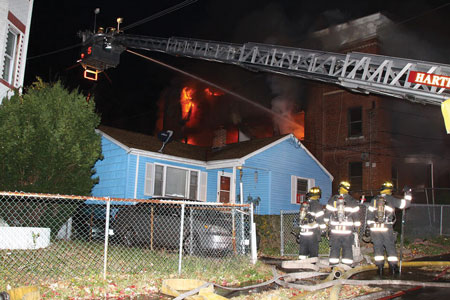 |
| (3) The apparatus has been positioned at the corner of the fire building outside of the collapse zone and in a position to protect the most severely threatened exposure. |
Positioning in this situation is not just about maximizing scrub area; it is about achieving crucial scrub area, which involves several factors including where the fire is, where the fire would go if control efforts are not immediately effective, what tactics will be used at the fire, and what are the most likely potential targets for the aerial device. Each department follows its standard operating procedures while fighting a fire. These procedures tell us where our members will be operating within the structure and what responsibilities the truck crew has for supporting offensive structural firefighting efforts. This is the standard information used to determine the possible targets the aerial device may need to reach. In most cases, the device needs to reach the roof and selected upper-floor windows. The location of the fire dictates which areas need to be accessed. Many times, it is not necessary to reach the fire room windows; the windows to the rooms surrounding the fire room are more crucial. This is where members most likely will appear if they are in trouble and where they will need to enter to search.
Possible Scenario
Following is a possible scenario. You have fire showing on arrival on a second-floor A/B corner, and there is no obvious rescue or need for exposure protection. The most likely position for the turntable would be somewhere near the A/D corner of the building. This location would allow scrub areas on two sides of the building, give access from the front to the roof and any dormers on the D side, and provide firefighter access/egress to the second-floor windows on the D side (photo 4).
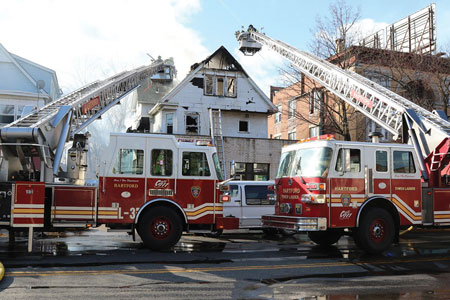 |
| (4) The first-arriving truck takes a position to support initial operations and leaves room for later-arriving apparatus to be able to support operations on the other side of the structure. |
These are the most likely points from which firefighters will emerge or to which they will require access to perform ventilation-entry-isolate-search. In this situation, if the apparatus is a rear-mount device, the position should be past the front of the fire building. It is important that both the aerial operator and the engine operator know and understand this. Later-arriving ladders can then cover the A/B corner of the building.
Do It Right the First Time
Knowing where to locate the turntable so that it supports the operations at a fire is key to tactical success. Stopping to determine the final position of the apparatus before spotting it is crucial. Many departments respond with only two firefighters on the aerial apparatus. The rider is most likely the individual who will “spot” the device. It is crucial that that member understand the capabilities and limitations of the device and what the intended uses of that device are. Once all the probable objectives have been identified, identify a single point from which all the targets can be reached given the length of the device and accounting for overhead obstructions. This is the point/location the turntable needs to be in to cover all of the identified objectives.
After the turntable position has been identified, consider the footprint of the aerial device-the space taken up on the street when the device is fully stabilized (photo 5). Assess obstructions on the street (manholes, storm drains, vaults underground, for example) and position the apparatus so the turntable remains in the proper spot and the footprint is clear of obstructions that would limit the operator’s ability to stabilize the device. Typical obstructions include parked cars, manholes, storm drains, other apparatus, and large-diameter hose. Since it takes time to fully bed an aerial device and move it to a new location and, in most cases, the apparatus crew is assigned other responsibilities once the apparatus had been set up, it is important to get the positioning right the first time.
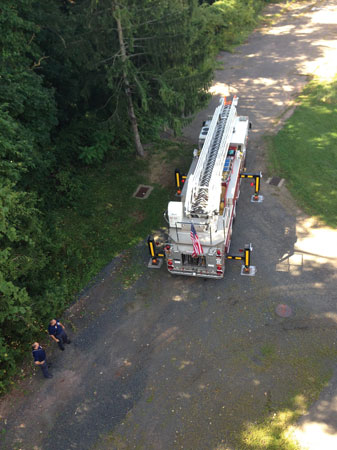 |
| (5) This photo shows the working footprint of this apparatus and what needs to be considered when selecting the final position for the apparatus to be deployed. (Photo by author.) |
After all of these issues have been considered, the spotter then directs the operator to the aerial’s final operating position (photo 6). To accomplish this task in a timely manner, members must drill on and practice the skills involved. Identifying all possible objectives and then working backward to the final position of the apparatus is a different approach from that most operators have been taught. Most texts discuss aerial placement in reference to a single objective or operation such as rescue, access to a window or roof, or ventilation. However, in most real-world settings, the device is used for several tasks, all from one position.
Like most activities firefighters perform, spotting aerial apparatus is a perishable skill. It is often difficult to find training time for this critical function. A good time for members to practice the skills involved is when training new drivers. Another time to hone these skills, which is almost always overlooked, is during nuisance runs. Operators and crew members can use these runs as opportunities to determine where they would position the apparatus for operations at that structure and get the apparatus into that position.
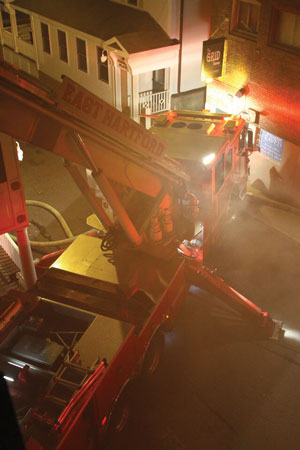 |
| (6) The apparatus has been spotted in a position that allows for support of operational objectives and compensation for aerial and stabilizer obstructions. |
Instead of “staging at the end of the block,” build the muscle memory needed to maintain proficiency in positioning aerials through drills and practice. Executing the basic activities with a high degree of proficiency keeps our operational tempo high; it is the cornerstone of a successful organization. All of the tactics outlined in this article depend on knowing the capabilities of your aerial apparatus. Dedicate training time to mastering the specifics of your apparatus. Seconds save minutes. Take the time to position the apparatus correctly the first time; this may prove vital later in the operation.
G. HOWARD BLYTHE is a 15-year veteran of and a firefighter in the Fire Department of New York, where he is assigned to Ladder Company 27 in the Bronx. Previous assignments include Ladder Company 15 and Ladder Company 113. He has BA and MS degrees from John Jay College in New York and Oklahoma State University in Stillwater. He is a nationally certified fire instructor III and fire officer IV. He is the program coordinator for the Connecticut Fire Academy Aerial program and is a H.O.T. instructor and presenter at FDIC International.
Safe and Effective Aerial Ladder Operations
Positioning Apparatus for Maximum Efficiency and Safety
AERIAL MASTER STREAM TACTICS
Fire Engineering Archives

